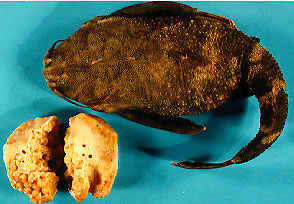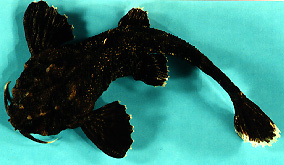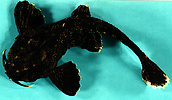Amaralia
John P. Friel- Amaralia hypsiura (Kner, 1855)
- Amaralia 'oviraptor' new species
Notes about Terminal Taxa: Taxa whose names appear in quotes on this Tree of Life page are undescribed. In accord with articles 8 and 9 of the third edition of the International Code of Zoological Nomenclature (ICZN, 1985), I do not issue this page for permanent scientific record. This page is designated an unavailable work for nomenclatural purposes. All names for new genera and species are provisional and will become available when my manuscript describing the type specimens is published in an official work such as a peer reviewed journal.
Introduction
This genus is rare in museum collections but is widely distributed in the Amazon and Paraguay-Parana River systems.
Friel (1992) presents evidence for oophagy within Amaralia based on examination of the stomach contents of 23 specimens (17 A. hypsiura & 6 A. "oviraptor"). Seven individuals had masses of eggs such as those llustrated below. The eggs are similar in appearance to those of loricariid catfishes and in one case ingested embryos could be positively identified as loricariids. The other 16 specimens had empty stomachs. This is in striking contrast to the stomachs of other aspredinids which always contained at least some detritus and invertebrates (aquatic insect larve and terrestial insects).


Characteristics
Diagnosis
A genus of medium sized banjo-catfishes (up to 133 mm SL) distinguished from all other genera of aspredinids by the following characters: contact between the frontal and supraoccipital bones; knobby ornamentation of the supracleithra; highly reduced dorsal fin with only 2-3 rays; deep, laterally compressed caudal peduncle; thickened "S" shaped procurrent caudal-fin rays; and trophic specialization on the eggs of other fishes. Other characters not unique to this genus but useful for identification include: head ornamentation well developed; 4 branchiostegal rays, pre-axial spine serrations reduced or absent and 9 caudal-fin rays.
References
Fowler, H. W. 1954. Os peixes de qua doce do Brasil. Arquivos de Zoologia do Estado de So Paulo, 9: 1-400.
Friel, J. 1994. A phylogenetic study of the Neotropical banjo catfishes (Teleostei: Siluriformes: Aspredinidae) Ph.D.thesis, Duke University, Durham, NC, 256 pp.
Kner, R. 1855 . Ichthyologische Beiträge. I. Über die Gattungen Aspredo und Chaca C. V. aus der Familie der Welse (Siluroidei). Sitzungsberichte der Mathematisch-Naturwissenschaftlichen Classe der Kaiserlichen Akademie der Wissenschaften, 8: 92-105.
Title Illustrations

| Scientific Name | Amaralia hypsiura |
|---|---|
| Image Use |
 This media file is licensed under the Creative Commons Attribution-NonCommercial License - Version 3.0. This media file is licensed under the Creative Commons Attribution-NonCommercial License - Version 3.0.
|
| Copyright |
© 1995 John P. Friel

|
About This Page
John P. Friel

Cornell University Museum of Vertebrates, Ithaca, New York, USA
Page copyright © 2009 John P. Friel
 Page: Tree of Life
Amaralia .
Authored by
John P. Friel.
The TEXT of this page is licensed under the
Creative Commons Attribution License - Version 3.0. Note that images and other media
featured on this page are each governed by their own license, and they may or may not be available
for reuse. Click on an image or a media link to access the media data window, which provides the
relevant licensing information. For the general terms and conditions of ToL material reuse and
redistribution, please see the Tree of Life Copyright
Policies.
Page: Tree of Life
Amaralia .
Authored by
John P. Friel.
The TEXT of this page is licensed under the
Creative Commons Attribution License - Version 3.0. Note that images and other media
featured on this page are each governed by their own license, and they may or may not be available
for reuse. Click on an image or a media link to access the media data window, which provides the
relevant licensing information. For the general terms and conditions of ToL material reuse and
redistribution, please see the Tree of Life Copyright
Policies.
- First online 05 July 1995
- Content changed 14 April 2000
Citing this page:
Friel, John P. 2000. Amaralia . Version 14 April 2000 (under construction). http://tolweb.org/Amaralia/15258/2000.04.14 in The Tree of Life Web Project, http://tolweb.org/








 Go to quick links
Go to quick search
Go to navigation for this section of the ToL site
Go to detailed links for the ToL site
Go to quick links
Go to quick search
Go to navigation for this section of the ToL site
Go to detailed links for the ToL site